Everything You Need to Know About Hot Water Baseboard Heaters
If your home is heated by a gas- or propane-fired boiler, this addition to our series of blogs focused on homes heated by hot water will focus on what’s probably the most recognizable component of these kinds of central heating systems: hot water baseboard heaters.
Also known as hydronic (as in water) heating systems, boiler systems were once very common in older homes, and they remain a popular home heating option today for many good reasons. These include the ability to provide separate, personalized comfort zones within the home, as well as the unobtrusive uniform heating that hot water systems are known for.

What Is a Hot Water Baseboard Heater?
A hot water baseboard heater is a type of hot water heat distribution product that is installed along the base of walls, in the same location as base cove molding, in place of the molding wherever the heaters are installed. Hot water baseboards contain a copper pipe (normally ¾” in residential use) with aluminum fins to transfer heat, and is housed in a white or off-white metal enclosure.
It’s important to remember that baseboard heaters require good air circulation in order to deliver heat effectively and efficiently. They cannot be hidden behind a sofa, bed, or other obstruction that would prevent them from performing properly. Whenever possible, baseboard heaters are installed along exterior walls in the home and below windows to provide optimal heat distribution. However, this is not a hard-and-fast rule, and each room within the home is addressed as needed by the experienced plumber you work closely with in determining the baseboard layout. In the Denver-Boulder area, our plumbers and heating technicians at Save Home Heat is a great contractor choice for homeowners.
What’s the Difference Between a Baseboard Heater and a Radiator?
While baseboard heaters and radiators both deal with hot water heat distribution, baseboard heaters operate primarily by the process of convection. Air moving through the aluminum fins in the baseboard enclosure gains heat and then is naturally distributed upward and into the room. Radiators, on the other hand, do their job mainly by radiating heat; the closer you stand to the heater the warmer you feel (think of a wood stove). This being said, the caveat is that both baseboard heaters and radiators actually provide both convective and radiant heating, each with their predominant means of accomplishing that.
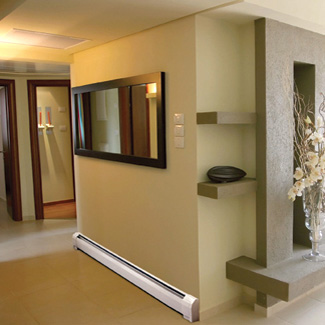
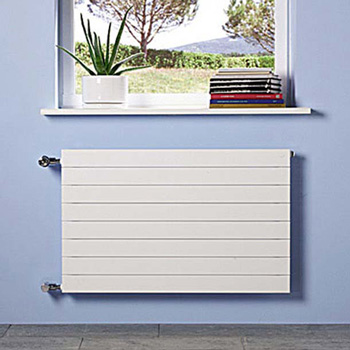
How Many Baseboard Heaters Are Needed?
Without getting too much into the weeds, the basic idea is that we calculate the heat load for the entire home, as well as for each room, individually. Once we determine these heating needs (measured in BTUs per hour), we specify an appropriate linear footage of baseboard heater for each room, while also making sure there are plenty of baseboards total to deliver all the heat supplied by the boiler. Every baseboard heater has a heat-output rating per linear foot of heater, and it’s important that this is properly matched with the needs of each room. The offshoot is that larger rooms, such as a living room or great room, require more baseboard heaters than smaller rooms. In some of these cases, it may make sense to discuss options such as high capacity baseboards with your heating contractor. More on that in a moment.



Understanding Hot Water Baseboard Heater Performance & Options
Most manufacturers’ standard residential hot water baseboard heaters perform similarly. However, baseboard heaters are now available in a variety of heat-output ratings. High-capacity baseboards, as well as specialty models, some with lead times requiring good planning and patience, are not uncommon for use in applications where greater heating is desired.
High Capacity Baseboard Heaters
Many manufacturers now offer a variety of high-capacity, also known as high output, baseboard heater options, with a broader range of heating levels that weren’t available until fairly recent years. These models offer heat output ratings as high as 40% greater than standard baseboards, and are great options to consider when wall space is limited or heating requirements are particularly high. Generally, high capacity baseboards look similar in appearance to traditional units, but are a little taller, with a slightly deeper enclosure.
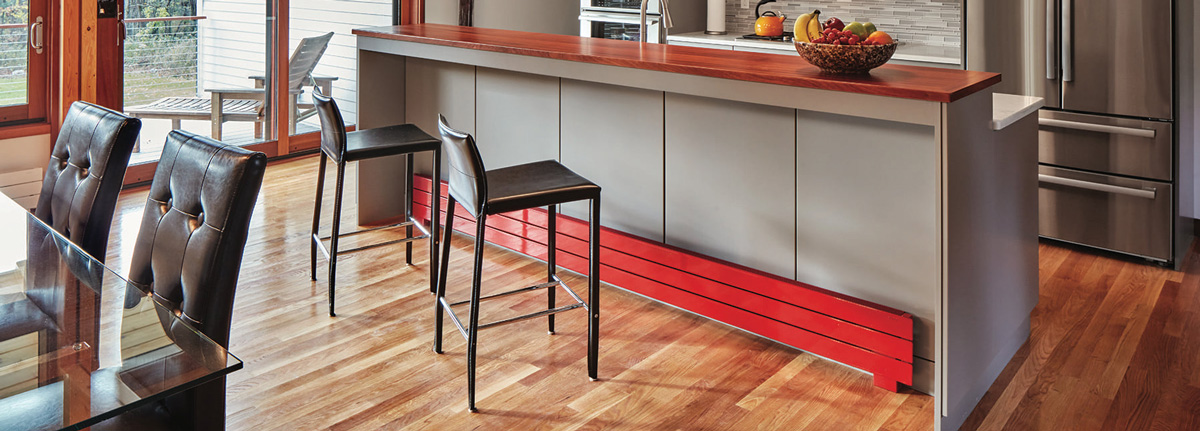
Baseboard Heater Styles and Variations
 With the exception of certain high end manufacturers – the Runtal brand often comes to mind – hot water baseboards almost always come in a standard shade of white or off-white. If you’re looking for a specialty color, the best course of action might be to work with your home painter (with consideration to surface preparation, type of paint, durability, etc.).
With the exception of certain high end manufacturers – the Runtal brand often comes to mind – hot water baseboards almost always come in a standard shade of white or off-white. If you’re looking for a specialty color, the best course of action might be to work with your home painter (with consideration to surface preparation, type of paint, durability, etc.).
As alluded to above, there are a limited number of baseboard manufacturers who supply a range of custom made, modern style, high-end baseboard and radiator products in a variety of colors. These products are generally somewhat costly, and lead times to obtain product should be checked carefully and taken into consideration when planning your job.
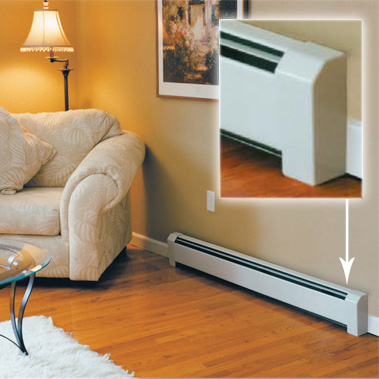
Baseboard Heater Accessories
It’s worth mentioning that certain accessories are used regularly to make your baseboard heaters appear as finished products and fit your home’s aesthetic. A variety of enclosure trim pieces are used to join lengths of baseboard heater together, turn corners, and aesthetically seal the end of heater runs. The most common of these include inside and outside, 90 degree and 45 degree corner trim pieces, splice plates, and endcaps.
Unusual Baseboard Heater Sounds
For the observant homeowner, during operation of your hot water heat baseboard system, there’s the possibility that certain sounds could develop, at times, which may be wise to have looked at by a pro. They could be minor annoyances, or perhaps warning signs that a greater issue could be developing. Here’s a quick rundown of what our customers and our team occasionally hear:
Gurgling & Bubbling Sounds
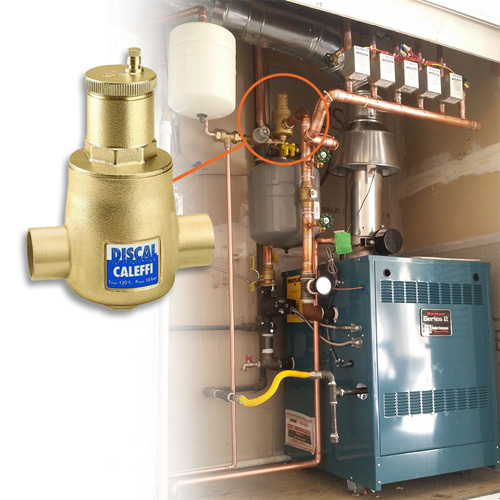 Bubbling and gurgling sounds in the system are often associated with air in the lines, which if this turns out to be the case, can often be resolved by an experienced service technician or plumber. Carefully bleeding small amounts of air from the system at coin vents located by many of the baseboards around the home may be all that’s needed – that is, assuming that ‘bleeder 90s’ were used when the system was installed.
Bubbling and gurgling sounds in the system are often associated with air in the lines, which if this turns out to be the case, can often be resolved by an experienced service technician or plumber. Carefully bleeding small amounts of air from the system at coin vents located by many of the baseboards around the home may be all that’s needed – that is, assuming that ‘bleeder 90s’ were used when the system was installed.
In some cases, we may discuss replacing an old cast iron air purger, located by the boiler, with a micro-bubble air separator. Micro-bubble air separators do a much better job removing air from the system, helping to achieve optimal heating effectiveness and efficiency, and keeping things running as quietly as possible. They are standard equipment with our team on all boiler installations.
In other cases, we have found an aging circulator pump may no longer be performing up to spec, potentially causing noise or performance issues in a variety of locations.
As you can see, there’s a variety of causes possible causes when gurgling, bubbling sounds start coming from a hot water home heating system. The best first step is to consult your experienced, trusted heating team to learn more about what’s going on.
Creaking & Pinging From Pipes & Baseboards
As baseboard heaters and the piping connecting them heat up and cool down, there may be sounds associated with the expansion and contraction of the enclosures and the fasteners securing them. While we can’t promise that there may not occasionally be a relatively small amount of these sounds as the ‘nature of the beast’ in some systems, excessive amounts of these sounds could be associated with loosely or improperly installed enclosure or trim pieces, or poorly hung baseboard heater element, for example. Depending on the origin of the sound, this could be a relatively easy fix for someone familiar with these products, or, in other cases, if the source is concealed behind drywall or lumber, maybe not so much.
Your Trusted Denver-Boulder Team for Hot Water Baseboard Heaters
Whether you’re interested in upgrading heat delivery from your boiler, quieting it down, or improving efficiency and comfort with a new system, our team at Save Home Heat Company is dedicated to providing our customers in the Boulder-Denver metro area with knowledgeable, professional advice and recommendations in an informative, low-pressure manner. We’ll listen carefully to you, answer all your questions fully and patiently, and provide with you with possible courses of action that make sense for you to consider. No hype, no sales agenda, focused squarely on your input and your best interests. Please contact our team today to learn more, or to schedule a free installation quote.
Please contact me to discuss my hot water home heating system!
Tags: Heating, Plumbing & Drains



